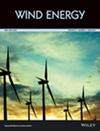Identifying the flap side‐edge noise contribution of a wind turbine blade section with an adaptive trailing edge
IF 3.3
3区 工程技术
Q3 ENERGY & FUELS
引用次数: 3
Abstract
Summary Active trailing-edge technology is a promising application for localized load alleviation of large-diameter wind turbine rotors, accomplished using one or more control surfaces in the rotor blade’s outer region. This work focuses on identifying noise contributions from the flap side-edge and the trailing edge in a laboratory condition. Measurements were conducted in the Acoustic Wind tunnel Braunschweig (AWB) at the German Aerospace Center’s (DLR) Braunschweig site. The small-scale model has a span of 1200 mm and a chord of 300 mm. The control surface, a plain flap, has a span of 400 mm and a chord length of 90 mm. Far-field noise was measured using a phased-microphone array for various flow speeds, angles of attack and flap deflection angles. For sound source identification, two noise reduction addons were installed interchangeably: trailing-edge brush and flap side-edge porous foam. Analysis of the far-field noise reveals that, while changes to the flap deflection angle alter the far-field noise spectra, the trailing-edge noise remains the predominant noise source at deflection angles − 5 ◦ and 5 ◦ . No additional noise level was observed from the flap side-edge within the measurable frequency range at these angles. The flap side-edge noise has an increased role for frequency larger than 2 kHz for the larger flap deflection angles of − 10 ◦ and 10 ◦ . Furthermore, numerical reproduction of the results will also be presented using the FMCAS (Fast Multipole Code for Acoustic Shielding) toolchain developed at DLR.识别具有自适应后缘的风力涡轮机叶片截面的襟翼侧边噪声贡献
主动后缘技术是大直径风力涡轮机转子局部减载的一种很有前途的应用,它使用转子叶片外部区域的一个或多个控制表面来实现。这项工作的重点是在实验室条件下识别来自飞边和后缘的噪声贡献。测量是在德国航空航天中心(DLR)布伦瑞克基地的声学风洞(AWB)中进行的。小型模型的跨度为1200 mm,弦长为300 mm。控制面为平面,跨度为400 mm,弦长为90 mm。使用相位麦克风阵列测量不同流速、迎角和迎角的远场噪声。为了识别声源,两个降噪附件可互换安装:后缘刷和侧缘多孔泡沫。对远场噪声的分析表明,虽然折射角的变化会改变远场噪声频谱,但后缘噪声仍然是折射角-5时的主要噪声源◦ 和5◦ . 在这些角度下,在可测量的频率范围内,从侧面边缘没有观察到额外的噪声水平。当频率大于2 kHz时,当折射角为−10时,折射侧边缘噪声的作用会增加◦ 和10◦ . 此外,还将使用德国航空航天中心开发的FMCAS(声屏蔽快速多极码)工具链对结果进行数值再现。
本文章由计算机程序翻译,如有差异,请以英文原文为准。
求助全文
约1分钟内获得全文
求助全文
来源期刊

Wind Energy
工程技术-工程:机械
CiteScore
9.60
自引率
7.30%
发文量
0
审稿时长
6 months
期刊介绍:
Wind Energy offers a major forum for the reporting of advances in this rapidly developing technology with the goal of realising the world-wide potential to harness clean energy from land-based and offshore wind. The journal aims to reach all those with an interest in this field from academic research, industrial development through to applications, including individual wind turbines and components, wind farms and integration of wind power plants. Contributions across the spectrum of scientific and engineering disciplines concerned with the advancement of wind power capture, conversion, integration and utilisation technologies are essential features of the journal.
 求助内容:
求助内容: 应助结果提醒方式:
应助结果提醒方式:


